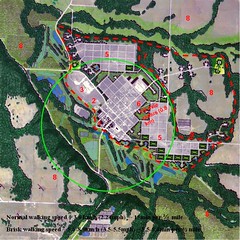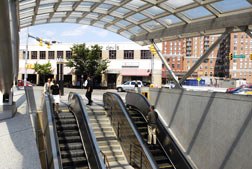New book ‘Green Community’ defines and illustrates sustainable neighborhoods, towns, cities

Posted November 13, 2009 at 1:41PM
 I am most pleased to announce the release of Green Community, a new book produced and published jointly by the National Building Museum and the American Planning Association. It's a terrific book of essays, if I do say so. (Full disclosure: one of them is mine.)
I am most pleased to announce the release of Green Community, a new book produced and published jointly by the National Building Museum and the American Planning Association. It's a terrific book of essays, if I do say so. (Full disclosure: one of them is mine.)
Federal Housing and Urban Development Secretary Shaun Donovan was kind enough to review the book for us:
"Today, more than any time in history, we live in a global economy where quality of place drives the free flow of capital. And as the lines between urban, suburban, and rural challenges blur, from poverty to housing affordability, strong neighborhoods are increasingly becoming a yardstick with which we measure America's success. Green Community is a definitive work on the sustainability challenge, offering us a blueprint for integrated transportation, housing, and land-use development and catalyzing a new generation of metropolitan and rural decision making that builds a geography of opportunity for every American."
I hope we have lived up to that. Roberta Brandes Gratz and Harriet Tregoning also have chimed in with much-appreciated reviews, and you can read their comments on the entry in the website of APA's Planners Press.
 I am honored (if not necessarily worthy) to be associated with an outstanding collection of co-authors, from friends like Jonathan Rose and Fred Hansen to professional collaborators like Dick Moe, Bill Browning and Howie Frumkin, to quite a few other impressive people I've gotten to know mainly through the project. Two of them are Tim Mennel of APA and Susan Piedmont-Palladino of the Building Museum, who managed and edited the book and have been a pleasure to work with.
I am honored (if not necessarily worthy) to be associated with an outstanding collection of co-authors, from friends like Jonathan Rose and Fred Hansen to professional collaborators like Dick Moe, Bill Browning and Howie Frumkin, to quite a few other impressive people I've gotten to know mainly through the project. Two of them are Tim Mennel of APA and Susan Piedmont-Palladino of the Building Museum, who managed and edited the book and have been a pleasure to work with.
The museum's website explains the overall concept:
"The book and its essays focus on the interconnectivity of density and transportation, conservation and preservation, energy and resources, and local health and global health. The contributors represent a diverse range of backgrounds and perspectives, resulting in a multi-disciplinary collection of essays which examine the people and places of sustainable communities. This publication presents the opportunities and challenges for planning and designing sustainable communities, and demonstrates that creating sustainable communities is critical to the long-term health of our environment and our economy."
In addition to the essays, the book includes photographs and explanatory diagrams, and allows its sponsors to extend the life of the museum's ambitious exhibition, also titled Green Community, which is currently concluding a year's run and which several of my co-authors and I had the pleasure of advising.  Curated by Susan Piedmont-Palladino, the exhibition has been the first in the US to explore the complex process of creating and sustaining healthy communities. Some of my favorite smart developments, such as Atlantic Station, Highlands' Garden Village, Greensburg, Arlington County, and Atlantic Station, are featured. There are also a couple of examples in the exhibit that I do not especially love, generally because they are isolated or low-density, which will create environmental problems; but Susan took an expansive view of what might be "green" in one sense or another, and that's fine for exposing people to various aspects of these issues. (See images with this post for a few of the featured places.)
Curated by Susan Piedmont-Palladino, the exhibition has been the first in the US to explore the complex process of creating and sustaining healthy communities. Some of my favorite smart developments, such as Atlantic Station, Highlands' Garden Village, Greensburg, Arlington County, and Atlantic Station, are featured. There are also a couple of examples in the exhibit that I do not especially love, generally because they are isolated or low-density, which will create environmental problems; but Susan took an expansive view of what might be "green" in one sense or another, and that's fine for exposing people to various aspects of these issues. (See images with this post for a few of the featured places.)
In the book, I love the approach that some of my co-authors have taken. Tim Beatley of the University of Virginia, for example, begins his provocative chapter by declaring that "one of the alarming dimensions of the current economic crunch is just how illusory our economic wealth and assets seem to be." Instead, Beatley argues, real wealth comes from connections to nature via biophilia, and through valuing time over monetary accumulation.  Communities can be located, designed, and nurtured in ways that support these values.
Communities can be located, designed, and nurtured in ways that support these values.
Sir Peter Hall, whose essay opens the book and would be a hit with me if only because it begins with a reference to James Thurber, places the concept of sustainability in a historical and international context. Mary Rickel Pelletier makes the point that there is no green urbanism without also "blue urbanism" that shows respect for waterways.
My own contribution ("Round Round Get Around: Reducing Transportation Burdens in the Green Community") discusses how location, neighborhood pattern and design, and complete, connected and inviting streets influence travel within and around communities. In addition to Tim Mennel, my friend and longtime APA associate Marya Morris provided very good editorial feedback on my chapter.
 One thing that pleases me about how the book came together is that, although some of us do get wonky here and there, the book is as much philosophy (what is a green community?) as prescription (how to create one). It provides answers to the questions many of my NRDC colleagues have been asking during our current strategic planning process, in which some of us are seeking to elevate these issues to the forefront of our organization's agenda.
One thing that pleases me about how the book came together is that, although some of us do get wonky here and there, the book is as much philosophy (what is a green community?) as prescription (how to create one). It provides answers to the questions many of my NRDC colleagues have been asking during our current strategic planning process, in which some of us are seeking to elevate these issues to the forefront of our organization's agenda.
If I have a quibble, it's that the book's font seems tiny and somewhat low-contrast to me. Reading glasses may be advised. Of course, you won't need them for your ears: several of us have also been featured in podcasts about the book and its concepts, which you can listen to here.
I've rummaged around the web to see if I can find a table of contents for you, but I can't, at least not yet. Instead, I'll just say for now that the essays are grouped into four main categories - density and transportation, conservation and preservation, energy and resources, and local and global health. An eloquent conclusion was supplied by Congressman Earl Blumenauer. Contributors not yet mentioned include Robert Lang, Mariela Alfonzo, Patrice Frey, Doug Porter, Thomas Daniels, Scott Malcolm, Marcel Aillery, Erica and Mark Heller, James Lagro, Carolyn Steel, and Esther Sternberg. I've learned something from each of the chapters I've read so far.